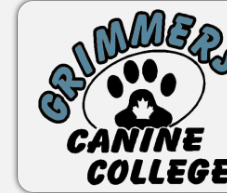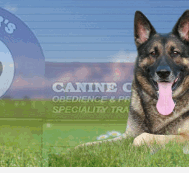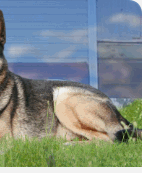




|
Bill is perhaps the ONLY dog trainer in the business that has such a vast experience of working and training dogs not only as pets and companions, but for all aspects of dog “work”.
Bill has trained dogs for the disabled, the police, rescue personnel, explosive and narcotic intervention and cadaver recovery. His understanding of “dog control” and teaching is unequalled. Contracted by municipalities and cities to address their animal problems, his techniques for solving problems with dogs is refreshing.
He began his specialized canine security operation in 1980 from his Scoudouc, New Brunswick kennel. Today, he is an internationally respected and accomplished dog trainer working in the Americas, Caribbean, South America, and Europe.
His training ability speaks for itself. He and his dogs have worked rescue missions in the former USSR and the Austrian Alps. He has trained narcotic and explosive detector dogs for foreign government agencies in United States and South America. Police agencies in Canada and elsewhere regularly sought his assistance and advice. Bill was the recipient of the prestigious YMCA PEACE Medal in 1989 and is designated as a World YMCA “Peacemaker” for his rescue volunteer work in the Armenia USSR earthquake.
Bill designed, taught, and successfully completed a project with the Texas Narcotic Control Program that trained over 100 specialized narcotic detector canines and their handlers. Over 15 million in asset seizures occurred in the 1st year of the 5 year project alone.
He has authored 2 training manuals related to service dog work and canine emergency first aid, and his knowledge is formidable on those subjects.
Bill also designed and taught two programs for narcotic and explosive detector dogs for the National Police Force of Guyana, South America through CESO, a Canadian organization funded by CEDA.
Whether looking for contraband on oilrigs in the North Atlantic Ocean, or along the Amazon River tributaries in South America, his dogs are and continue to be successful.
The company of BGMDT K9 is a licensed security company with the New Brunswick and Nova Scotia Police Commissions. Handlers from the company provide a gamut of canine related security services from protection to detection.
Grimmer’s Canine College
In 2003 Bill built “Grimmer’s Canine College” in Shediac with his daughter Vanessa as a partner. Vanessa is an accomplished and renowned animal groomer and she operates the day to day function of the store and shop at 59 Ohio Road. He also operates the security operation from there, however with his increase in age and work developed from the training aspect; he is downsizing the security facet.Curriculum vitae
Bill’s exhaustive curriculum vitae follow outlining his extensive knowledge in the training and utilization of working dogs.Related Experience:
- Operator of BGMDT K9, a company using dogs and handlers in various aspects of security work, narcotics recovery, explosive detection and asset protection. BGMDT works internationally and licensed with all appropriate Federal, Provincial and/or State agencies.
- Consultant to the New Brunswick Canada, Power Commission on the use of dogs in security for the protection of Point Lepreau Nuclear Plant
- Graduate of special education
courses held by the Sam Houston State University, Criminal Justice Center,
Huntsville Texas, USA, on theft and narcotic contraband in the oil industry
Consultant to Dresser Oil Corporation, Houston Texas, USA for the use of dogs to detect contraband narcotics in the oil field - Contraband investigator using dogs to locate contraband alcohol and narcotics on offshore 0il rigs and work installations
- Mobil Oil Canada Limited
- Zapatta Offshore Canada Limited
- Rowan Oil Canada Limited
- LASMO Offshore Canada Limited
- Irving Oil Canada Limited
- Set Legislative precedent for the formation of regulations for the use of security dogs in the province of Nova Scotia, Canada
- Operated 15 of the company security dogs in five (5) major Canadian police labor strikes
Past Civilian Police dog handler for:
- St. George Police Department, St. George, New Brunswick, Canada
- Shediac Police Department, Shediac, New Brunswick, Canada
- New Brunswick Highway Patrol, New Brunswick, Canada
- First, dog handler to train and successfully use dogs in water recovery of a body in Canada
- Licensed by Health and Welfare Canada to train and use dogs to locate narcotics. (the first non-law enforcement person to be so licensed - 1985 - )
- Licensed by the DEA (Drug Enforcement Agency) in United States as a ``researcher'' to train and use dogs to locate narcotics (1983-1986)
- Licensed teacher by the Province of New Brunswick Canada Community College to teach security and security dog related subjects (1986)
- K-9 police trainer and civilian handler for Huntsville Texas Police Department, Huntsville Texas USA (1983-1990)
- Honorary deputy sheriff and police dog handler for Walker County Sheriff's Department, Huntsville Texas USA (1982-1983)
- K-9 Reserve officer and police
dog handler/trainer for Trinity Police Department, Trinity Texas USA
(1982-1983)
 Past
K-9 Police trainer for:
Past
K-9 Police trainer for:
- Madison County Sheriff's Department, Madison Texas USA (1983)
- Essex County Sheriff's Department, Essex County, Mass. USA (1992)
- Hillsborough County Sheriff's Department, Tampa Florida USA (1991)
- Jasper County Sheriff's Department, Jasper Texas USA (1984)
- Monroe County Sheriff's Department, Monroe County, Indiana USA (1984)
- Guyana National Police, Guyana, South America (1992)
- Tampa Police Academy, Tampa, Florida, USA (1991)
- Sam State University, Police Academy, Huntsville, Texas USA (1984-1985)
- Texas Narcotic Control Program, Fort Worth, Texas USA (1993-1997)
- Sackville Police Department, Sackville, N.B. Canada (1994-1997)
- Aransas County, Texas Sheriff’s
Department K9 Teams (1999-)
Past K-9 Fire Department trainer for:
- Shediac, New Brunswick Fire Department, Canada (1999 - )
- Charlottetown Fire Department,
Prince Edward Island, Canada (2000-)
Author of: - "POLICE DOG DEVELOPMENT", a training manual on developing the police service dog
- "POLICE DOGS", a booklet on the tactical use of K-9 teams
- “K9 OD” a manual
and charts describing emergency first aid for detector dog poisoning
Past National Director of Canadian Search and Rescue Dogs (CANSARD) a non-profit network of Canadian volunteer search and rescue dogs - Team leader for Canadian Search Dog Teams that went to the Stuybal Glacier in Austria in search for Duncan MacPherson, a Canadian youth lost in the Alps (1989)
- Team leader for Canadian Search Dog Teams that went to Armenia, Russia at the earthquake in 1988
- Certifying Official (Judge) for the Texas K-9 Police Association
- Certifying Official (Judge) for the International Canine Narcotic Detection Foundation
- Member United States and Canadian Police Canine Association (CPCA & USPCA)
- Member National Association of Security Personnel (NASP)
- Member International Narcotic Enforcement Officers Association (INEOA)
- Board of Director member of the Moncton City Zoo (1997- )
- Weapons expert in the use of hand and non-lethal ancient and modern police weapons - registered
- 2nd degree black belt in the Okinawan and Japanese Karate system of ``Chito-Ryu''
- Self-defense instructor to police departments in Canada and United States
- Certified “Black Badge” International Practical Shooting Confederation
- Certified Rescue and Master SCUBA diver National Association of Underwater Instructors - trained in rescue, recovery, cavern, marine ID, and wreck penetration work
- Certified Technical SCUBA diver
in the use of mixed gas diving (NITROX)
Film Credits
- Wrangler for Dave Wright Show, ATV, Halifax, NS, Canada (1985)
- Wrangler/trainer for TCJC, Narcotic Dog Program training video, Fort Worth, Texas (1995)
- Wrangler/trainer for “Emily of New Moon” TV Series PEI Canada (1996)
- Wrangler/trainer for “Adventures of Peter York” feature film - Fredericton N.B. (1999)
- Wrangler/trainer for “Black Eyed Dog” feature film - Moncton N.B. (2004)
- Wrangler/trainer for “Stuck” feature film – Saint John N.B. (2005)
- Wrangler/trainer for “United
States Humane Society PSA commercials” – Hollywood CA and
New York City NY (2006-2007)
Here is what a few have said of his expertise…
“thank you for your exemplary service you have provided” – Bill Hogan, Charlottetown Fire Department Fire Services Manager, for training their accelerant detector dog and handler.
“the answer to our prayers for the development of an accomplished K9 section” – L.A. Smith, deputy Commissioner Law Enforcement, Guyana Police Force
“the subject you and your dog located has been charged with numerous criminal offences, one of which is impaired driving causing death” - A/Sgt. K. Ayotte – NBH Police, NCO i/c Memramcook Detachment
“on behalf of myself and Kouchibouguac National Park I would like to thank you for your assistance during the search for the above noted persons” – Michel Savoie, Chief Park Warden, Kouchibouguac National Park
“ I want you to know that your response is more than appreciated by our detachment” – C.J. Mew, Sgt. I/C and J.P.C. Brunette Shediac RCMP Detachment
“as the result of the work performed by Mr. Grimmer and his dog several charges are now before the court concerning this case” – K. M. Fraser, Cst. RCMP Shediac
“I was amazed and curious about the search you and your dog successfully made in Shediac” – Cst. J.A.C.L. Beaucage, Underwater Recovery Team Supervisor, N.B. RCMP
“the fine efforts shown by your tracking dogs was of utmost value to our case” - W.D White, Sheriff, Walker County Texas
“gratitude and thanks for your participation in rescuing works in Armenia” – A. Rodionov, Canadian Ambassador to Canada for Premier M.S. Gorbachov
“Grimmer possess a very strong ability to relay his knowledge’, “instructor is outstanding”, “Bill is the most motivated instructor I have ever had”, “Bill was a great trainer”, “best course I ever attended” – some remarks from students at the Texas Narcotic Control Program – 1996-
"Flame" The Accelerant Detector Dog
During the past several years, accelerant detection dogs have become commonly visible at fire scenes. These professionally trained dogs can detect various flammable and combustible liquid odor residues found at fires scenes. Canines have the ability to detect these odors at low levels. The canine is a valuable tool that can assist the fire investigator in locating these flammable and combustible liquid odors at fire scenes.
HISTORY
In the mid 1980's a group of Bureau of Alcohol Tobacco and Firearms (BATF) agents started to research the possibility of using dogs to detect the presents of flammable liquid residues at fire scenes. On May 1, 1986 the State of Connecticut Police began its first training program with a black female Labrador retriever named Mattie. Tests proved that she could detect 17 different odors.There were a few detector dogs in Canada. Tom Hutton of Ontario Fire Marshal's Office and former OPP (Ontario Provincial Police) canine officer has trained at least three accelerant dogs and are in use in Ontario. In Nova Scotia, Frank Savage a former firefighter with Cole Harbour Fire Department, now a Deputy Fire Marshal for the Province of Nova Scotia had success with his Yellow Labrador "Major" which he informally trained and utilized.
How a detector dog is used....
Once the canine had alerted, a sample should be taken and submitted to a laboratory for analysis and confirmation. The laboratory plays an essential role in the detection of the presence of a flammable or combustible liquid in the submitted sample. Without laboratory analysis, the fire investigator is unable to determine if the sample does indeed contain hydrocarbon residue. It is essential that laboratory analysis is being performed on each and every sample that is taken at a fire scene. Comparison samples should also be taken and submitted to the laboratory for analysis. The canine is a useful tool to assist the fire investigator in the determination of these odors a t the fire scene.The canine should be used as a tool and should not replace the basic investigative skills needed by the fire investigator to determine the origin and cause of the fire. One advantage to using the canine is that the number of samples that are taken at a fire scene can be reduced thus reducing the cost of sample analysis.
At this time there is no set of national standards for canine accelerant detection dogs and handlers. Standards are currently being developed as part of National Fire Prevention Association (NFPA) NFPA 921. If the canine does alert, then a sample can be taken from that area for analysis. The canine can decrease the time that it takes an investigator to process the scene.
Presently the CADA (Canine Accelerant Detection Association) have standards and perform certifications in North America.
Canine accelerant detection dogs have proven themselves as a useful tool to assist the fire investigator. Utilizing an accelerant detection dog as part of your fire investigation can easily be achieved. We offer the use of a certified accelerant detection dog on a nationwide basis. The accelerant dog and the handler can be called to support your Special Investigation Unit investigators or other private fire investigators already on the scene.
SAVE TIME - SAVE MONEY
Utilizing an accelerant detection dog is a time saving and money saving tool that should be used by fire investigators on a regular basis. Once you have seen an accelerant detection dog work at a fire scene, you will realize the important role that these canines play in fire scene analysis.Bill Grimmer has trained the first such detector dog in Atlantic Canada. Working and training with the Shediac Municipal Fire Department the dog is available on a user fee basis to other fire departments, fire investigators and insurance adjusters in the Atlantic area.
BGMDT's dog is a Labrador Retriever named "FLAME". Flame was the product of a local Moncton breeder "Haddondale Kennels" and was aptitude tested by Bill when only 8 weeks old. She began her initial (first level) training at 13 weeks of age and can easily detect the presence of hydrocarbons at fire scenes.
CONTACT
To learn more about the services and training of the BGMDT K9 accelerant detection dog:
Phone: (506) 532-8852, Fax: (506) 532-6368 or contact by E-mail: grimmer@rogers.com
"Tengu" The LSD Detector (2000-2013)
Only 18 pounds and 10 inches high and he could find LSD anywhere. Just LSD? ...Not likely! Tengu a diminutive Shiba Inu (Japanese breed dog) could locate marijuana, heroin, cocaine , methamphetamine and Amphetamines. In fact, in 1996 he was certified by the Texas Police K9 Association.
The Texas Police K9 Association is a major certifying agency in the State for law enforcement K9's. It has members from State police, municipal ,city police and federal agencies such as the Border Patrol. The testing official said identical statements when Tengu went in the room and when he left the room. He said, "That dog can find drugs?" upon entering the testing area and he said it again with an exclamation rather than a question mark when the dog was finished.
Tengu was tested along with 12 other police dogs and was one of only 5 that certified on all drugs. Rooms and cars have drugs surreptitiously placed in areas designed to confuse the handler and the teams have a time limit to find them. Not only was Tengu the smallest competitor among the Labradors, Shepherds and Malinois but was also one of the youngest. At only 7 months old he was by far the youngest "certified" narcotic detector dog in Canada.
He also claimed the distinction of being the only LSD detector dog in Canada and perhaps the USA at that time. Training to detect LSD was not done in the past because the substance is so dangerous to use. Chemical effects of a micro-dot can be absorbed through the skin and be disastrous to the animal. The SIGMA Chemical Company in St. Louis Missouri selected Bill to work with a drug dog training aid they developed called "pseudo LSD". The product, while safe to dogs, mimics the actual odor that real LSD emanates thereby allowing safe training conditions. Bill and Tengu worked with the new formula and then tested on real Lysergic Acid Diethylamide. The stuff worked, Tengu had proven to be able to locate quantities as small as 5 micro-dots hidden in cabinets, books and vehicles.
Why a small, friendly, "cute" dog to detect drugs and firearms? Bill decided it was time to train a small non-intrusive dog to detect contraband for use by private industry as well as law enforcement agencies. A small dog can travel easier, get into small confined spaces more comfortably and best of all, be accepted by the public. Besides training and teaching Bill's work entails contraband searches on offshore oil rigs, remote lumber camps and retail businesses and working with a big scary dog can be contra-productive. A dog like Tengu is accepted by adults and children alike and schools can use such a dog with positive results and acceptance.
Bill has been working with the United States government through the Texas Narcotic Control Program since 1993. His pilot project there has developed over 105 narcotic detector dog teams with various law enforcement agencies in the State. Working from the Fort Worth located Tarrant County Criminal Justice Center dogs and their handlers attend special training modules designed to teach the dogs exceptional detection capabilities. From time to time, dogs brought from Canada by Grimmer are tested along with the resident teams for their abilities. By 1995 the project has amassed over 13 million ($13,000,000) in assets and narcotic related seizures.
Presently, there is in excess of 155 metric tons of cocaine and 23 metric tons of heroin seized worldwide per year and the street prices have dropped to less than $100. Per gram. There is a lot of money at stake in narcotics and it is thought that almost 70% of the illicit trade destined for the Canadian-US market enters through the Texas-Mexican borders.
Educators agree that information is the best way to curb the use of killer drugs and interdiction at the school level necessary to protect our youth. More and more school districts are developing protective plans to find and rid schools and impressionable young children of drug temptations. One of the best eradication techniques involves the use of detector dog teams working in the schools. These teams are privately contracted, police arranged or "in-house" operations and either way competent dogs are needed.
A concern of the school districts, parents and students is the perceivable image that detector dog teams makes, small, friendly dogs are always better accepted. New "in-house" school programs have the students themselves handling the detector dogs as a resident mascot.
Grimmer's Canine College
| Home | Private Training / Celebrity Dogs | Scent Detection Services | Security Services |
| Who is Bill Grimmer | Dogtra Pro-Staff | Contact Us |
| Find us on Facebook | Linked in |


